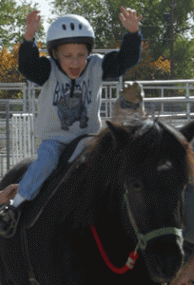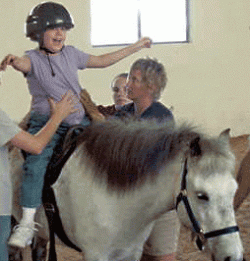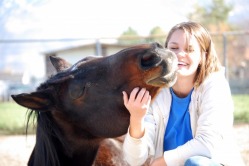Therapeutic Riding Lessons
(offered by a NAHRA Instructor)

Therapeutic horseback riding differs from traditional therapy in the sense that it offers physical activity combined with the development of a skill. With this skill the students can: share their talent with family and friends experience the excitement and fun of competition enjoy the learning process build self-confidence improve concentration and attention span learn memory and sequencing abilities progress in speech gain social skills
Riding therapy involves living, breathing animals. So students enjoy the well-documented benefits of pet therapy, including improved socialization, increased compassion and responsibility, and better communication. Each hard-working therapy horse is carefully selected for the individual rider.
Riding is dynamic. The three-dimensional movement of the horse helps to:
• improve posture and balance
• improve spatial orientation and body awareness
• increase circulation
• relax rigid muscles
• stimulate natural hip movement and development in the non-ambulatory
• tone and strengthen muscles
• improve coordination
• improve fine and gross motor skills
Non-Disabled Riding Instruction

While our first mission is to serve those with disabilities, we also offer the use of our horses and facilities to those without disabilities on a limited basis. Preferential consideration is given to other family members or friends wishing to join a disabled rider during their instruction time.
Beginning through intermediate, western or English, group and private instruction is available. Our kind and gentle horses, along with the ability to provide volunteers, makes our Center an excellent choice for first time riders. For advanced lessons we recommend other facilities and instructors, since it is likely the rider will require a horse with more advanced training, responsiveness, and athletic ability then what might be available at the Center.
Other one-time options may be horseback riding as part of a special date, birthday party, or family activity. Our horses are used only on our property under the direction and supervision of an instructor. Also available is the use of a pony driven cart.
Hippotherapy Sessions
(offered by a Licensed Physical Therapist, Occupational Therapist, or Speech-Language Pathologist)

Hippotherapy is a term that refers to the use of the movement of the horse as a treatment tool by Physical Therapists (PT), Occupational Therapists (OT), and Speech-Language Pathologists to address impairment, functional limitation, and disabilities in patients with neuromusculoskeletal dysfunction. Hippotherapy is used as part of an integrated treatment program to achieve functional outcomes.
In hippotherapy, the patient engages in activities on the horse that are enjoyable and challenging. In the controlled hippotherapy environment, the therapist modifies the horse’s movement and carefully grades the sensory input. Specific riding skills are not taught (as in the therapeutic horseback riding); but rather a foundation is established to improve neurological function and sensory processing. This foundation can be generalized to a wide range of daily activities. Hippotherapy patients tend to be the best motivated PT and OT patients because the work is fun!
The horse’s walk provides sensory input through movement, which is variably rhythmic and repetitive. The resulting movement responses in the patient are similar to human movement patterns of the pelvis while walking. The variableness of the horse’s gait enable the therapist to grade the degree of sensory input for the patient, and then use this movement in combination with other treatment strategies to achieve desired results. Patients respond enthusiastically to the enjoyable experience in a natural setting.
General Indications for Hippotherapy
Population – children & adults with mild to severe neuromusculoskeletal dysfunction Impairments that may be modified with hippotherapy are:
Abnormal tone
Impaired balance responses
Impaired coordination
Impaired communication
Impaired sensorimotor function
Postural asymmetry
Poor postural control
Decreased mobility
Limbic system issues related to arousal, motivation, and attention Functional limitations relating to the following general areas may be improved with hippotherapy:
Gross motor skills such as sitting, standing, and walking
Speech and language abilities
Behavioral and cognitive abilities
Medical Conditions
The primary medical conditions, which may manifest some or all of the above listed problems and may be indications for hippotherapy, are listed below. However, hippotherapy is not for every patient. Specially trained health professionals should evaluate each potential patient on an individual basis.
• Autism
• Cerebral Palsy
• Cerebral Vascular Accident
• Developmental Delay
• Down Syndrome
• Functional Spinal Curvature
• Multiple Sclerosis
• Sensory Integrative Dysfunction
• Traumatic Brain Injury
Equine Assisted Psychotherapy
(Offered by a Licensed Psychotherapist and Horse Specialist)

Equine Assisted Psychotherapy (EAP) is an emerging field in which horses are used as a tool for emotional growth and learning. EAP is a collaborative effort between a licensed therapist and a horse professional. Because of its intensity and effectiveness, it is considered a short term or “brief” approach.
EAP is experiential in nature. This means that participants learn about themselves and others by participating in activities with the horses, and then processing (or discussing) feelings, behaviors, and patterns. This approach has been compared to the ropes courses used by therapist, treatment facilities, and human development courses around the world. But EAP has the added advantage of utilizing horses, who are dynamic and powerful living beings.
Not all programs or individuals who use horses practice Equine Assisted Psychotherapy. For one, licensed clinical professionals need to be involved for it to be considered “psychotherapy.” The focus of EAP is not riding or horsemanship. In fact, 100% of EAP takes place on the ground. The focus of EAP involves setting up activities involving the horses which will require the client or group to apply certain skills. Non-verbal communication, assertiveness, creative thinking and problem-solving, leadership, work, taking responsibility, teamwork and relationships, confidence, and attitude are several examples of the tools utilized and developed by EAP.
EAP is a powerful and effective therapeutic approach that has an incredible impact on individuals, youth, families, and groups. EAP addresses a variety of mental health and human development needs including behavioral issues, depression, anxiety, relationship problems, and communication needs.
Why Horses?
Those who are familiar with horses recognize and understand the power of horses to influence people in incredibly powerful ways. Developing relationships, training, horsemanship instruction, and caring for the horse naturally affects the people involved in a positive manner.
The benefits of work ethic, responsibility, assertiveness, communication, and healthy relationships has long been recognized. Horses naturally provide these benefits. The use of horses is growing and gaining popularity with the rise of new approaches to working with horses, including the field of Equine Assisted Psychotherapy.
We are often asked, “Why horses? Why not other animals?”
Horses are large and powerful, which creates a natural opportunity for some to overcome fear and develop confidence. The size and power of the horse are naturally intimidating to many people. Accomplishing a task involving a horse, in spite of those fears, creates confidence and provides for wonderful metaphors when dealing with other intimidating and challenging situations in life.
Horses are very much like humans in that they are social animals. They have defined roles within the herds. They would rather be with their peers. They have distinct personalities, attitudes, and moods. An approach that seems to work with one horse, does not necessarily work with another. At times, they seem stubborn and defiant. They like to have fun. In other words, horses provide vast opportunities for metaphorical learning. Using metaphors, in discussion or activity, is an effective technique when working with even the most challenging individuals or groups.
Horses require work, whether in caring for them or working with them. In an era when immediate gratification and the “easy way” are the norm, horses require people to be engaged in physical and mental work to be successful, a valuable characteristic in all aspects of life.
Most importantly, horses have the ability to mirror exactly what human body language is telling. Many people will complain, “The horse is stubborn. The horse doesn’t like me,” etc. But the lesson to be learned is that if they change themselves, the horses will respond differently. Horses are honest, which make them especially powerful messengers.
(copied with permission from the EAGALA web site)
